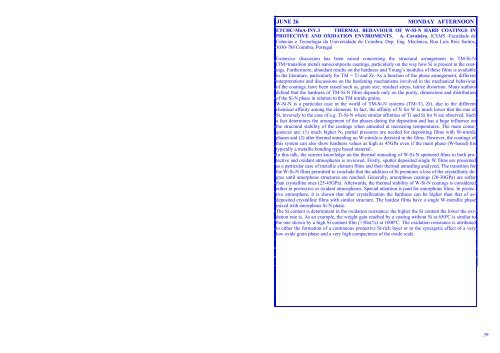Wüest M. 51 Wykes M. 82 Yamaguchi M. 17 Ybarra G. 129 Yubero F ...
Wüest M. 51 Wykes M. 82 Yamaguchi M. 17 Ybarra G. 129 Yubero F ...
Wüest M. 51 Wykes M. 82 Yamaguchi M. 17 Ybarra G. 129 Yubero F ...
You also want an ePaper? Increase the reach of your titles
YUMPU automatically turns print PDFs into web optimized ePapers that Google loves.
JUNE 26 MONDAY AFTERNOON<br />
ETCHC-MoA-INV.3 THERMAL BEHAVIOUR OF W-SI-N HARD COATINGS IN<br />
PROTECTIVE AND OXIDATION ENVIROMENTS. A. Cavaleiro, ICEMS -Faculdade de<br />
Ciências e Tecnologia da Universidade de Coimbra, Dep. Eng. Mecânica, Rua Luís Reis Santos,<br />
3030-788 Coimbra, Portugal<br />
Extensive discussion has been raised concerning the structural arrangement in TM-Si-N<br />
(TM=transition metal) nanocomposite coatings, particularly on the way how Si is present in the coatings.<br />
Furthermore, abundant results on the hardness and Young´s modulus of these films is available<br />
in the literature, particularly for TM = Ti and Zr. As a function of the phase arrangement, different<br />
interpretations and discussions on the hardening mechanisms involved in the mechanical behaviour<br />
of the coatings, have been raised such as, grain size, residual stress, lattice distortion. Many authors<br />
defend that the hardness of TM-Si-N films depends only on the purity, dimensions and distribution<br />
of the Si-N phase in relation to the TM nitride grains.<br />
W-Si-N is a particular case in the world of TM-Si-N systems (TM=Ti, Zr), due to the different<br />
chemical affinity among the elements. In fact, the affinity of N for W is much lower that the one of<br />
Si, inversely to the case of e.g. Ti-Si-N where similar affinities of Ti and Si for N are observed. Such<br />
a fact determines the arrangement of the phases during the deposition and has a huge influence on<br />
the structural stability of the coatings when annealed at increasing temperatures. The main consequences<br />
are: (1) much higher N 2 partial pressures are needed for depositing films with W-nitride<br />
phases and (2) after thermal annealing no W-nitride is detected in the films. However, the coatings of<br />
this system can also show hardness values as high as 45GPa even if the main phase (W-based) his<br />
typically a metallic bonding type based material..<br />
In this talk, the current knowledge on the thermal annealing of W-Si-N sputtered films in both protective<br />
and oxidant atmospheres is reviewed. Firstly, sputter deposited single W films are presented<br />
as a particular case of metallic element films and their thermal annealing analyzed. The transition for<br />
the W-Si-N films permitted to conclude that the addition of Si promotes a loss of the crystallinity degree<br />
until amorphous structures are reached. Generally, amorphous coatings (20-30GPa) are softer<br />
than crystalline ones (25-45GPa). Afterwards, the thermal stability of W-Si-N coatings is considered<br />
either in protective or oxidant atmospheres. Special attention is paid for amorphous films. In protective<br />
atmosphere, it is shown that after crystallization the hardness can be higher than that of asdeposited<br />
crystalline films with similar structure. The hardest films have a single W-metallic phase<br />
mixed with amorphous Si-N phase.<br />
The Si content is determinant in the oxidation resistance: the higher the Si content the lower the oxidation<br />
rate is. As an example, the weight gain reached by a coating without Si at 650ºC is similar to<br />
the one shown by a high Si content film (>30at.%) at 1000ºC. The oxidation resistance is attributed<br />
to either the formation of a continuous protective Si-rich layer or to the synergetic effect of a very<br />
low oxide grain phase and a very high compactness of the oxide scale.<br />
39
















